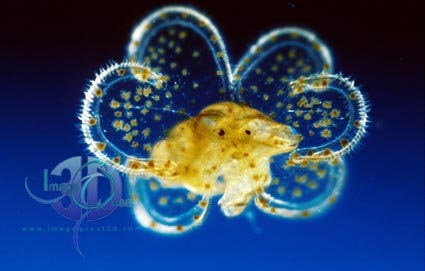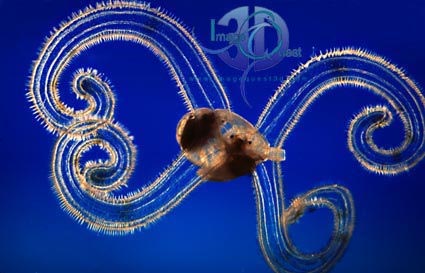|
"Ballad of the Veliger or how the Gastropod
got its Twist"!

|
|||||||||
|
Veligers! My true favourites of all the plankton larvae. They encapsulate so much of what this amazing subject is all about. Already I have mentioned the group in passing. That huge group of creep-footed animals that belong to the Mollusc phyllum and which we commonly call gastropods. They are widely, successfully and very fully represented in the marine fauna of this planet. The group includes slugs and snails and a few oddities and any Natural History Museum of Victorian origin will contain thousands of beautifully arrayed snail shells. The reason the shells are there is because a) they are beautiful but b) they are extremely durable. Part of this durability lies in their crystalline, mineral composition and density. With this density comes weight. No problem having weight if you slither across the sea floor, in fact it is an advantage, it helps to stop you being knocked off your perch by waves, currents and over-energetic fish. But it is a problem, a grave problem, if you are lumbered with the same heavy shell while you are a planktonic larval snail, called a veliger and trying to drift, swim, paddle and fly around as close to the surface of the ocean as possible for the first ten weeks or so of your life. It is for this very reason, namely trying to keep from sinking with their heavy shell, that veligers developed the enormously elaborate wing of beating cilia. In some species this wing and its double row of cilia is so active that it looks as if the young snail larva is surrounded by a hoop of flickering fire. To me it is so perfect, so beautiful, so well conceived that it attains the very pinnacle of natural design. The snails, over the millenia, have also evolved a peculiar twist in their bodies to enable their guts, mouth, stomach, liver and anus as well as their gills and their defence weapons and their heads and feet etc. all to crowd into their elegant spiral shells. To the delight of many an old time plankton enthusiast like myself, my old professor, Sir Alister Hardy, revitalized his Oxford predecessor's quirky ability to write poetry about these strange biological facts and foibles. Professor Walter Garstang was Sir Alister Hardy's father-in-law, his wife Sylvia was Walter's daughter. I thought it a fitting end to this account, therefore, to conclude with Garstang's: "Ballad of the Veliger or how the Gastropod got its Twist"! The Veliger's a lively tar,
the liveliest afloat, He's witnessed several changes
in pelagic motor-craft; Young Archi-mollusks went
to sea with nothing but a velum - But when by chance they
brushed against their neighbours in the briny, Their feet, you see, amidships,
next the cuddy-hole abaft, A fleet of fry turned out
one day, eventful in the sequel, Predaceous foes, still drifting
by in numbers unabated,
Doesn't that just say everything not only about the subject of plankton, but also its depth and breadth and also about the amazing early marine biologists? They did so much to unravel some of the extraordinarily complex details buried deep within the life of plankton.
Gastropod Veliger ©
2001 by Image Quest 3-D
Read our copyright notice
|


